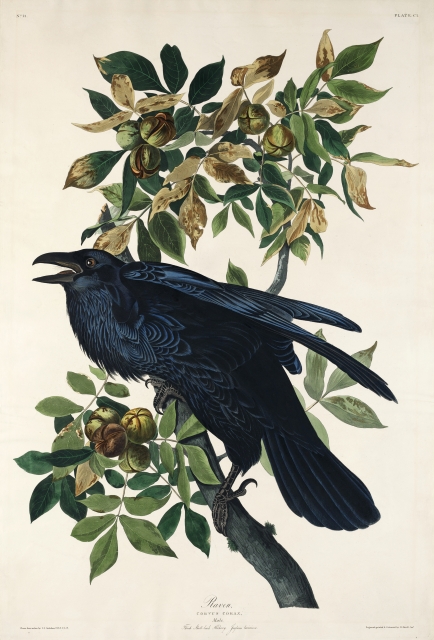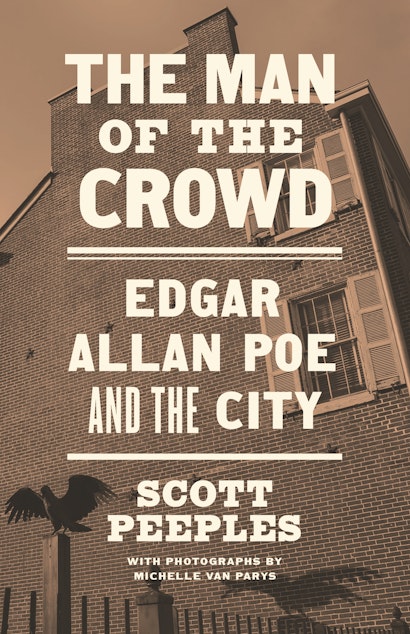If there were ever an American writer you would not associate with the suburbs, it’s Edgar Allan Poe. His popular image tends to be that of an isolated figure, oblivious to his surroundings. When that image is countered, it’s likely replaced by a more accurate one of Poe as a creature of the mid-nineteenth-century American city, specifically Richmond, Baltimore, Philadelphia, and New York. In fact, that image is the essence of my recent book, The Man of the Crowd: Edgar Allan Poe and the City. But throughout the book, I also point to recurring instances when Poe sought to live outside the city proper, and yet still within reach.
But did suburbs really exist in Poe’s time, specifically 1809-1849? Clearly not on the scale that they would in the auto-centric mid-twentieth century, or even the late nineteenth-century world of extensive commuter rail lines. But as Maura D’Amore explains in her book Suburban Plots, Americans began embracing a suburban ideal well before the civil war, and Poe’s more successful contemporaries in the literary world were at the vanguard. D’Amore’s prototypical suburban man is Washington Irving, whose idyllic retreat, Sunnyside, became a tourist destination even as it served as a private home. Popular writers and public figures such as Irving, Ik Marvell, Henry Ward Beecher, and Nathaniel Parker Willis constructed a suburban ideal that appealed to American men generally—“country life within city reach,” as Poe’s friend and one-time employer Willis promoted it.[1] In her study Building Suburbia, Dolores Hayden refers to early suburbs as “borderlands,” pointing out that “the periphery of the city in this era was not the country. The edge was neither rural nor urban.”[2] Sometimes the “edge” encompassed farms, sometimes factories, sometimes planned developments, and often all three.
The problem for Poe was that he never had sufficient wealth to accomplish the suburban ideal of Irving’s Sunnyside or Willis’s Idlewild. He never owned his own home or even a carriage to ease the commute to the city center, where the business of publishing took place. His first move from to the outskirts of a city came in 1833, when a 24-year-old Poe joined the household of his aunt Maria Clemm in Baltimore. In this instance the motivation was almost certainly to reduce the household’s rent. Poe, along with his aunt, his grandmother, his eleven-year-old cousin Virginia, and possibly his fifteen-year-old cousin Henry, moved from the bustling Fells Point area to a recently built duplex about a mile and a half west of central Baltimore. Although they occupied two floors and an attic, the space was very small, about 600 square feet. Gas streetlights did not extend that far from the city center, and water would have to be carried from a nearby canal or well. The first-floor fireplace was surely inadequate for providing heat to upstairs rooms. This was not upward mobility, and it was more like an urban frontier than a suburb.
Yet Poe would follow this pattern of settling initially in the more densely populated, older section the city before seeking less expensive lodging on the outskirts in both Philadelphia and New York. When he, Virginia (now his wife), and Maria moved to Philadelphia in 1838, they settled at a boarding house on Mulberry Street (today’s Arch Street), in an increasingly commercial and industrial area a few blocks from the Delaware River. But within a few months, the family relocated to a less densely populated area near Sixteenth and Locust Streets, in the western half of the city. Philadelphia was expanding in that direction (as well as to the north and the south). Lawyer Philip Physick’s Greek Revival mansion was constructed on Rittenhouse Square while Poe was living nearby, signaling more fashionable future settlement. So the gentrification of their neighborhood might have precipitated the Poe-Clemm family’s next move, in September 1842, to the Fairmount District, northwest of what was then the city proper, near the Schuylkill River waterworks and the recently constructed Eastern State Penitentiary. At the same time, Virginia had just begun exhibiting symptoms of tuberculosis, creating a grim new reality for the family and another reason to live farther away from the more polluted streets and air of the city. The following year, they would move to North Seventh just above Spring Garden Street, closer to old Philadelphia but still about a twenty-minute walk to the center of business and, specifically, magazine and newspaper publishing. An acquaintance who later wrote a romanticized biography of Poe was probably correct in referring to the Spring Garden district of the 1840s as “a quiet suburb far from the dust and noise of the city.”[3]
Poe’s years in Philadelphia were among the most productive of his career: he wrote the majority of the tales for which he is known today, and for about a year he edited Graham’s, one of the most popular magazines in the country. But his failure to establish a magazine of his own, along with Virginia’s poor health, sent him into a destructive spiral of depression and heavy drinking, which damaged his reputation among other writers and editors. In early 1844 he set out to make a fresh start in New York, already the national cultural and publishing center.
Poe’s first two years in New York could be characterized as moving back and forth, in and out of what then constituted the city. After a few weeks at a boarding house, the family moved about five miles north to a farm owned by the Brennan family, near what is now the intersection of 84th Street and Amsterdam Avenue on the Upper West Side. It’s not known what, if anything, Poe contributed to the Brennan family coffers, but it probably wasn’t much, given his lack of steady income. In reminiscences published many years later, members of the Brennan family fondly described Poe as sober and content, appreciative of the bucolic natural setting. Moreover, during the eight months or so that he lived with the Brennans, Poe produced a steady flow of fiction and journalism while making regular trips, presumably on foot, to the offices of the New York Mirror, where he cranked out editorial filler. Most notably, he completed, or perhaps just revised, a poem he had written in Philadelphia, about a grieving scholar visited by a black bird in the middle of the night.
Around the time of the publication of “The Raven” in early 1845, Poe and family moved back downtown. After all, he had come to New York to advance his career, specifically to revive the prospects for his own magazine, so it made sense to be close to the publishing hub of Nassau and Fulton Streets. “The Raven” was a hit from the moment of its publication, but Poe’s moment in the sun was brief: while living in lower Manhattan (and moving frequently), his drinking and pugnacious professional behavior once again undid him. By the spring of 1846 he sought retreat—first boarding with another sympathetic family near Turtle Bay, on the East River in what is now Midtown, and then much farther north in Fordham, across the Bronx River, in early 1846.
In several ways this was a great move for Poe, Virginia, and Maria. The rent was only $100 a year. Fordham was 14 miles from the city, but it was on the Harlem Railroad line, with departures every four hours. So the area not-yet-named the Bronx really did offer that desired suburban combination of remoteness and proximity. Maria called their acre of land as a “sweet sequestered spot” (1117), and Poe referred to his “snug little cottage” in a July 1846 letter. The problem, of course, was money. Poe could earn more than a month’s rent by selling a manuscript, but he wasn’t selling many manuscripts in 1846, and his financial woes would continue until his death in 1849.
After Virginia died in January 1847, Poe and Maria continued to live in Fordham. Although he was devastated by his wife’s death, he recovered his emotional stability while at the Fordham cottage. But he tended to lose that stability when he traveled, which he did increasingly over the last eighteen months of his life, pursuing another wife and the elusive magazine-of-his-own. Tragically but fittingly, he was in transit when he died, at the first stop of an itinerary that began in Richmond and was to take him through Baltimore and Philadelphia on the way back to New York.
There are many patterns and repetitions in Poe’s life, but this tendency to seek habitations on the outskirts of the cities where he worked is among the most striking. Poe’s career as a journalist, editor, and writer of magazine fiction depended on the modern city, and he wrote evocatively about urban life in stories such as “The Man of the Crowd,” “The Murders in the Rue Morgue,” “The Mystery of Marie Roget,” and “The Purloined Letter.” But he clearly did not love city life, and he aspired to a suburban ideal that would have allowed him easy access to publishing centers along with the fresh air and relative seclusion of the country. As with so many aspects of Poe’s life, he almost made it.
Scott Peeples is professor of English at the College of Charleston. His books include The Afterlife of Edgar Allan Poe and Edgar Allan Poe Revisited.
Notes
[1] Maura D’Amore, Suburban Plots: Men at Home in Nineteenth-Century American Print Culture (Amherst: University of Massachusetts Press, 2014),
[2] Dolores Hayden, Building Suburbia: Green Fields and Urban Growth, 1820-2000 (New York: Vintage, 2004), 22.
[3] Susan Archer Weiss, The Home Life of Poe (New York: Broadway Publishing Co., 1907), 95.

